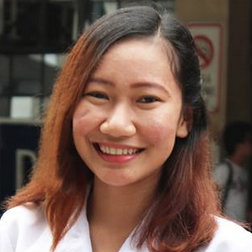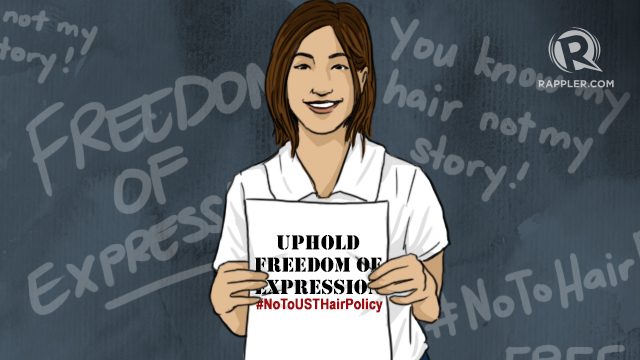SUMMARY
This is AI generated summarization, which may have errors. For context, always refer to the full article.
 The Faculty of Arts and Letters (AB) of the University of Santo Tomas (UST) suspended the haircut and hair color policy last year after a campaign was launched by students. But the AB administration has recently re-implemented the policy.
The Faculty of Arts and Letters (AB) of the University of Santo Tomas (UST) suspended the haircut and hair color policy last year after a campaign was launched by students. But the AB administration has recently re-implemented the policy.
The hair policy is part of the University of Santo Tomas’ Good Grooming Policy under the University’s Code of Conduct and Discipline (PPS Number 1027). It is stated that, “Good grooming includes the wearing of the prescribed college uniform, the authorized shoes, the ID, the male haircut and other considerations that are similar to these.” (READ: What UST students think of the #NotoUSTHairPolicy Campaign)
The hair policy reads, “Unless otherwise allowed by the administrators of the particular Faculty/College/Institute/ School for specific reasons, male students are not allowed to sport long hair. Hair should not touch the collar of the uniform.
The use of hairpins, pony tails, headbands, etc by male students is not allowed either.
There is no mention of a prohibition on hair color in the handbook.
How it started
However, AB students had been approaching me, reporting that they were being told by security guards in the building to dye their hair black.
Some also reported that the guards were taking their identification cards, and that the students were being ordered to go to the dean’s office. Alarmed by this, the Union of Journalists of the Philippines-UST (UJP-UST) tried to confirm the implementation of the policy, and found out that indeed, it would again take effect in AB.
UJP-UST, in order to give voice to Thomasians opposing the said policy and to inform people of what the students think, launched last week the #NoToUSTHairPolicy photo movement.
The student movement against UST’s hair policy is more than about students “ranting” for their supposed “vanity and narcissistic desires.”
It is seen as an issue of the lack of consultation with students – them being the primary stakeholders of the institution – in the policy making of the university. More than that, it has a clear link to the fascist or repressive character of the system of education here in the Philippines.
Before enrolling in UST, Thomasians would have to pledge agreement with the policies imposed by the university, or they would not be allowed to proceed in the enrollment procedures.
Students have no choice but to comply with the policies at hand, without questioning or having a say about them. It is appalling how students are dictated to “just follow rules,” no matter what the substance of the rule is, and “keep their opinions to themselves,” which is observably a way of teaching them uncritical submission and blind obedience.

By complying with the university’s haircut and hair color policy, students, most especially those in the College of Fine Arts and Design (CFAD) and UST’s liberal arts college, the Faculty of Arts and Letters, would have no freedom to express themselves through their hair color or hair length.
The policy also limits the promotion of student diversity, and can further limit how students who are part of the LGBTQ sector would want to express their gender.
Not a measure of one’s academic performance
Hair color and hair length do not, in any way, affect a student’s academic performance, and these surely do not determine an individual’s morality. The university being a Catholic institution would also not be considered a justification since there is no Papal Encyclical, Apostolic/Pastoral Exhortation, or anything written in the Bible which states that a person is immoral or less of a person because of his hair color or hair length. Having short hair (for men) or having black or “earth-colored” hair does not equate to being morally good. “Even Jesus Christ had long hair,” students would even point out. This is a clear manifestation that both hair color and hair length do not define one’s being.
Moreover, it is misleading to reason out that students must look “decent”– for there is no definite image of how a decent person must look like.
Also, the meaning of the word “decent” itself would be subjective to how people would define it.
The idea that these students would eventually need to have “proper grooming” once they enter the corporate world should also be crossed out since there are people with corporate jobs having different hair color, long hair, or various hair styles, and these do not affect their performance in their work.
Unncessary policies?
The more people try to justify such unnecessary policies, the more the students would conform and think it’s alright to obey without critical thinking.
To dismiss such issues and identify them as “petty” would result to students becoming indifferent and apathetic to all other issues concerning them. Furthermore, students will not be able to take part in solving larger and more important issues if they cannot solve simple ones such as these. – Rappler.com
Maria Denise Paglinawan is a 3rd year journalism student in UST. She is founder and chairperson of UJP-UST.
Add a comment
How does this make you feel?
There are no comments yet. Add your comment to start the conversation.